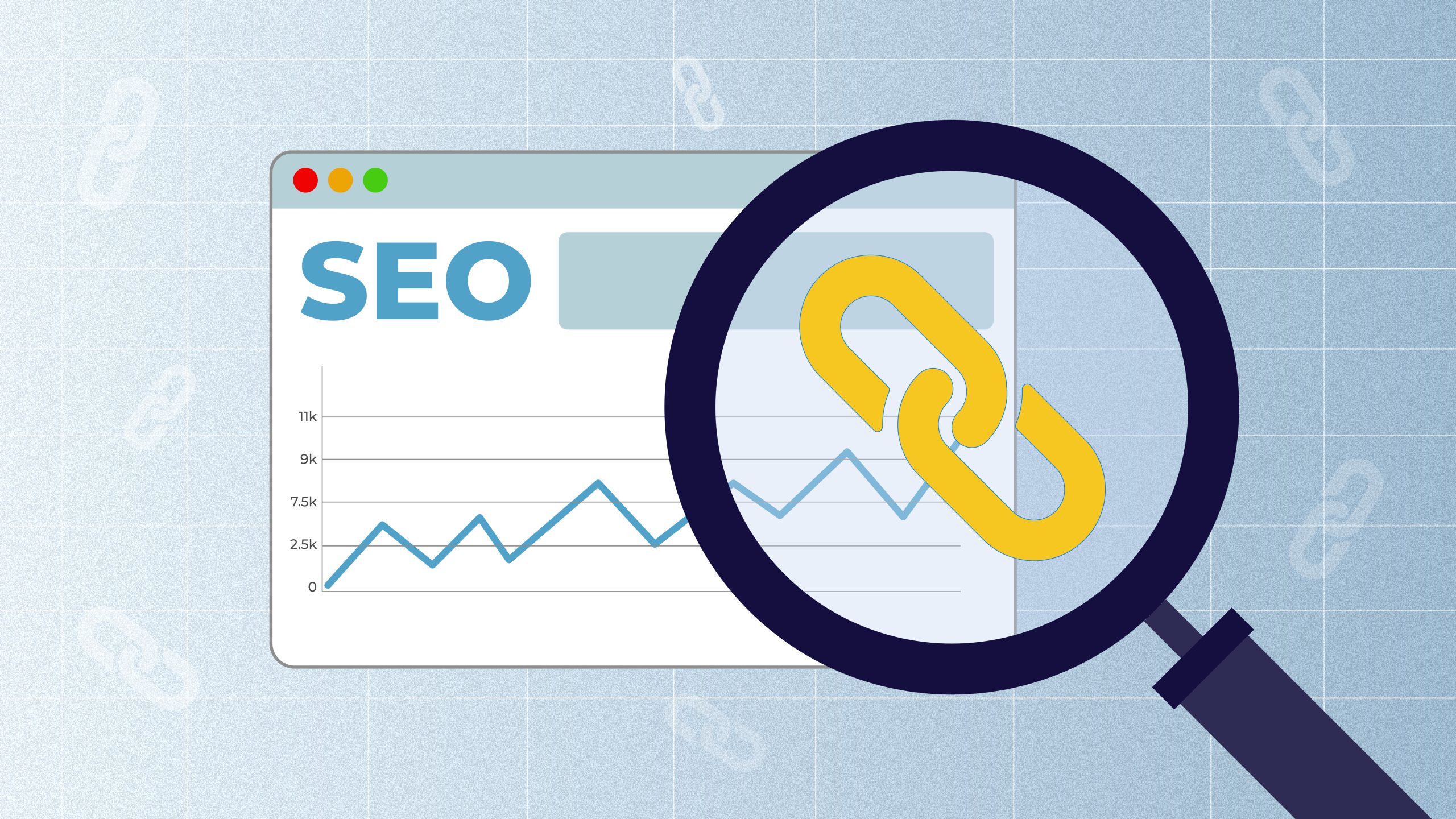Are you ready to find out how you can strengthen your link-building strategies? Then you are in the right place, as we will give you the ultimate guide on competitor backlinks analysis.
Don’t take our word about the power of backlinks, as the survey states that the 1st ranking position in the Google SERPs gets 3.8x more backlinks than other positions.
But how to rank better by using the power of competitor links?
One of the most effective ways of any digital marketing campaign is checking out your competitors. When it comes to SEO, it’s more than important to determine their link-building activities.
Moreover, by analyzing your competitor’s backlink profile, you can enhance your backlink strategy and significantly improve your off-site SEO tactics.
Keep reading, as we are going to suggest actionable tips to effectively find competitor backlinks and give steps on how to improve your backlink profile based on the collected data.
But first, what is this competitor link analysis, anyway?
Definition of competitor backlinks analysis
Competitor backlink analysis is the process of examining the link profiles of your main competitors’ websites.
By performing competitors backlink analysis, you gain insights into the types of websites and sources that have linked to them. Moreover, this strategy will help find out the quality and quantity of competitor backlinks and discover both advantages and weak points of their backlink profiles.
What is great about competitor link analysis is that it opens room for potential opportunities to get similar backlinks. Basically, it can guide you to build a more effective link-building strategy for your website.
But how does the competitor backlink analysis contribute to YOUR link-building strategy?
7 benefits of analyzing competitor backlinks
Do you still wonder why this process is essential and why you should invest effort into it? Let’s get a closer look at the key advantages of competitor backlink analysis:
✔ Uncover new link-building opportunities
It’s important to find competitor backlinks and analyze them, as it creates space for finding potential link-building opportunities. It provides valuable information about authoritative websites linking to your competitors.
Having this data in your hands, which you can get by using a backlink checker, you can come up with link-building outreach tactics for offering those reliable sources a collaboration and automatically increase your website’s authority.
✔ Improve your backlink profile
It’s hard to underestimate the importance of backlinks and doing competitive backlinking analysis to reach your link-building goals. This is because, when you find competitor backlinks, analyze them, and incorporate them into your link building strategy, you improve the quality of your backlink profile.
Additionally, it helps you keep an eye on what competitors are doing and discover the trends of their link-building strategies. After that, you need to build well-thought-out tactics on how to use the collected information to expand your link-building efforts.
✔ Expand link-building strategies
By doing backlink tracking of competitor websites, you can discover which backlink techniques are most effective and which type of websites and content rank well in search engine results.
By learning what they are doing differently, you can come up with new techniques to implement them in your link-building strategy.
✔ Find and bridge link gaps
When analyzing competitors’ backlink strategy, you can uncover competitor links that your website doesn’t rank for and ultimately craft a more targeted outreach strategy to gain backlinks from these sources. This is one of the best ways to find competitor links have built and recreate a new strategy.
An essential element in this stage is that you should not try to duplicate your competitor’s tactics. Instead, you need to use collected data about competitors’ backlink profiles to build your own unique link-building strategy and eventually outrank your competitors. In this case, always tracking backlinks and ensuring your keep up with competitors and important.
✔ Identify top-performing content
Another awesome benefit of backlink tracking of competitors’ websites is getting insights into their most successful content marketing tactics. You will find out what topics, formats, and types of content resonate with your target audience. Then you can use the information to enhance your link-building efforts.
But how?
First, Identify link-worthy content that has attracted relevant backlinks. In the next step, you can discover the types of websites that are more likely to link to your domain and the content formats that are effective for attracting backlinks. With this data in your hand, you can refine your link-building strategy and implement tactics to increase the effectiveness of your efforts. Lastly, make sure to reach out to these websites and suggest them to link to your content. Or maybe even publish a guest post?
✔ Avoid threats
By regularly analyzing your competitor links, you can track their backlink profiles over time and identify any sudden boosts or drops. What is great about this process is that you can identify and avoid threats to your own backlink profile.
Basically, you are learning from the mistakes that your competitors are making and are trying to avoid them. By identifying toxic or irrelevant backlinks, you can stay away from those practices and create a more organic, high-quality backlink profile.
✔ Learn niche trends
Lastly, you can find competitor backlinks and modify your strategies by watching the latest trends and developments in your industry. Also, you can discover new link-building strategies and use them as inspiration to modify your own. By being strategic, you can enhance your backlink strategy and even gain a competitive advantage.
How to analyze competitor backlinks in 4 steps
In case you are already convinced that conducting competitor backlink analysis is a beneficial idea, now you may be looking for effective strategies to implement it. Don’t worry, as we are here to offer tactics to analyze competitor backlinks effectively.

Step 1: Find your main competitors
This first step may seem obvious, but learning how to find competitor backlinks is the core of doing successful competitor link analysis.
When starting this process, keep in mind that you need to research two types of competitors: domain-level and page-level.
So, let’s talk about each type separately.
Domain-level competitors
You compete with your domain-level competitors across their whole domain. These websites categorize within the same niche as yours and typically target the same audience as you.
They not only battle for SERP rankings with you but target similar potential markets and compete with your offers. This means they are your direct competitors and target your main keywords in terms of SEO.
To research the domain-level competitors, you must analyze all competing domains’ backlink profiles. In the meantime, check what kind of different competitor analysis tools Ahrefs offers for a more professional approach.
You can find domain-level competitors on Ahrefs by following these steps:
Step1: Enter your Ahrefs account
Step2: Search your domain on Ahrefs
Step3: Click on Organic Competitors and see the results.
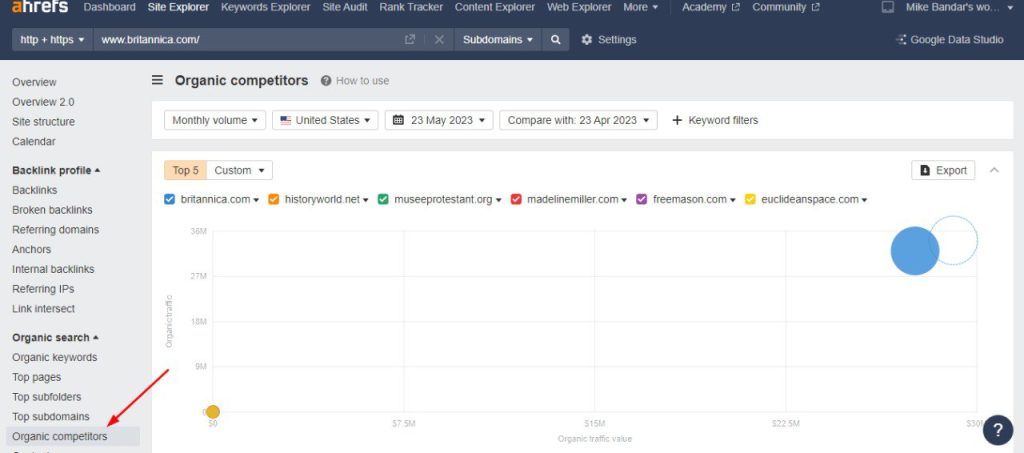
These are the domains that exist for the same reason as yours and have the same target goals.
But how different is the second group of competitors?
On the contrary to domain-level competitors, page-level competitors may not have the same customer pool and may not be trying to target the same audience as you.
Instead, the page-level competitor research only looks at the backlinks of a specific page.
And here’s how to find competitors backlinks using Ahrefs:
Step 1: Enter your Ahrefs account
Step 2: Enter the URL of the specific page for which you want to find competitors
Step 3: Choose “Exact URL“ and see the results.
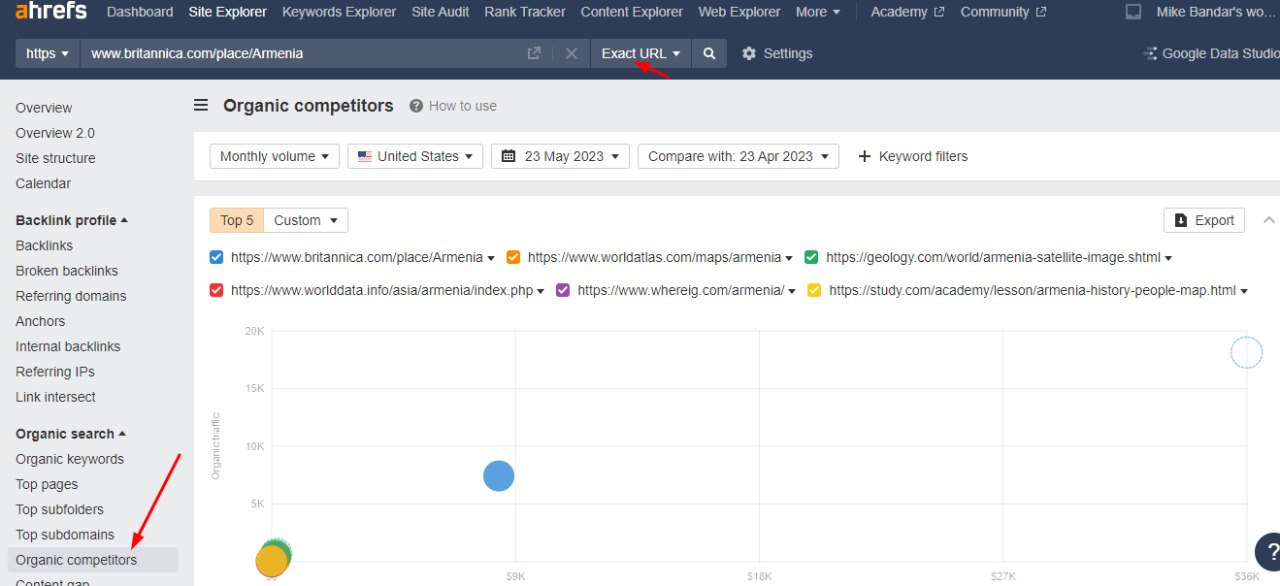
Got the difference?
After analyzing both types of competitors, you should create separate lists for each of them. Next, you need to build unique tactics on how you should try to outrank these two types of competitors.
Step 2: Analyze competitor keywords
Wanna learn how to check competitor links more effectively? It wouldn’t be any discovery to mention how important keywords are for boosting SEO efforts.
Basically, they play a crucial role for building successful SEO campaigns and are irreplaceable for doing competitor backlink analysis as well.
Chances are higher that you already have several keywords as an integral part of your link-building strategy. However, your job is to find new top-performing keywords so as not to miss out on exciting opportunities.
And yes, this is an ongoing process.
For that matter, as you have already defined your competitors in your niche, you should look for the anchor texts used for the backlinks linking to their websites. After that, check the relevance of the keywords used in the anchor texts to your own website.
Without a doubt, you should check the Keyword Difficulty, Search Volume, and other important metrics as well.
Furthermore, pay attention to user intent behind each keyword and highlight the ones that align with your link-building goals. By understanding the user intent behind specific keywords, you can discover relevant competitor links. Essentially, it will help you to make informed decisions and optimize your link-building efforts based on keywords.
By understanding the keywords that your competitors target and the websites linking to them, you can find and fill potential gaps in your own link-building strategy.
Step 3: Qualify all of your competitor backlinks
You already did a great job identifying and making a list of your main competitors.
It’s time to do a competitive backlinking analysis to uncover opportunities for improving your own backlink profile and SEO strategy because having many backlinks isn’t a sign of their quality.
One of the things to keep in mind is leveraging SaaS backlinks, as they increase your website traffic faster and give your website more trustworthiness. If you’re just getting started, read our SaaS link-building guide to find out how to do backlink qualification and boost Off-page SEO.
What to remember when qualifying competitor backlinks?
Follow several criteria and metrics that will guide you through the process:
✓Keep in mind the domain rating (DR) to find out how strong a site’s backlink profile is. This metric gives an idea of a website’s overall authority in search engine rankings. Ultimately, your goal should be getting backlinks from high DR websites because, considered more valuable and authoritative, they can increase your search engine rankings.
✓Consider the anchor text to get insight into the keywords your competitors are targeting with their link-building strategy.
✓Look for link gaps to identify domains that link to your competitors but not to your own website, which takes us to the next point.
Step 4: Perform backlink gap analysis
Simply put, a link gap is the difference in both the number and quality of competitor links.
So backlink gap analysis should be an important part of your competitor backlink analysis. By comparing competitors’ backlink profiles to your own, you can identify sites from where they get backlinks, but you don’t.
In this stage, it’s important to consider the quality and relevance of these backlinks to determine their value.
Let’s discuss this with an example. Assume that Oxfordre.com (Research Encyclopedias) wants to find out where its competitors, britannica.com and encyclopedia.com, have backlinks that they miss.
Step 1: Log to your Ahrefs account
Step 2: Click on Link Intersect
Step 3: In the section “Show me who is linking to these domains or URLs section” include competitors’ domains (britannica.com and encyclopedia.com)
Step 4: In the ”But doesn’t link to section ” include your domain (Oxfordre.com)
Step 5: Click “Show link opportunities” to perform the backlink gap analysis.
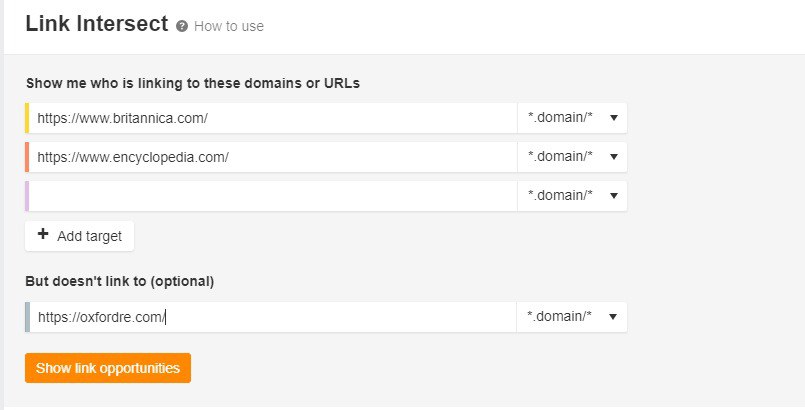
In the next step, check the relevance and authority of those websites that your competitors have backlinks from. Then try to create your own outreach tactics for getting backlinks from those domains as well.
How to build your own backlink strategy?
You did an excellent job doing competitor backlink analysis and following tactics on how to check competitor backlinks. But you may wonder what’s next and how you can use the collected data to enhance your link-building strategies.
So we will suggest some tactics that will guide you to develop your link-building strategy after this process.
1. Set clear link-building goals
Before anything else, define your objectives and decide what you want to accomplish with your link-building strategy.
Ensure that your goals are realistic and achievable and that you have enough resources to reach these objectives. Start a goal-setting process by defining the quality and quantity of backlinks you need to gain. Then evaluate your current backlink profile to identify areas for improvement.
In that matter, establish quality guidelines and determine your standards for a high-quality backlink. These guidelines ultimately will support the process of building a strong backlink profile.
In your future plans, you may reach out to the website editors or bloggers that you consider potential backlink sources convenient to your goals. Remember, to start an effective collaboration, you should showcase the value your content can deliver to their website visitors. Lastly, establishing transparent relationships within your industry enhances the likelihood of acquiring quality backlinks and reaching your link-building goals.
2. Check your website’s backlink profile health
In the next stage, one of the important steps that you shouldn’t ignore is checking the strength of your backlink profile. By examining your website’s backlink profile and keeping it healthy, you can build effective SEO strategies.
Basically, by regularly monitoring your backlink health and doing backlink audits, you can enhance your website’s authority and boost organic traffic.
✔ Quantity of backlinks
First and foremost, check the number of backlinks your website has because it’s one of the main signals of its popularity.
✔ Quality of backlinks
While quantity is an important factor, the quality of backlinks has significant power on your website’s backlink health.
✔ Relevance of backlinks
Check backlinks from websites that are topically relevant to your website’s content and are considered more valuable than your website in the industry or niche it operates.
✔Anchor text diversity
Having a diverse range of anchor text gives a signal to search engines about the context and relevance of the linked content.
Overall, monitoring and maintaining a healthy backlink profile can positively impact your website’s search engine rankings, organic visibility, and overall online reputation. Lastly, consider regularly checking your backlink profile health to find various issues and build strategies to acquire high-quality and relevant backlinks.
3. Replace broken competitor backlinks
Another tactic for developing your link-building efforts after doing competitor analysis is replacing your competitors’ broken links.
Start by finding competitors’ broken links from different domains. Then, offer these domains to replace those links with yours. This way, you can gain a competitive advantage and drive more traffic to your website over time.
Remember that when analyzing competitor backlink data, you should filter the broken backlinks, which lead to error pages (404) or expired domains. Next, consider the relevance and context of the broken links to determine whether they are suitable for replacement with your own content. Look for broken links that were originally pointing to content or resources that are similar to what you offer on your website.
Develop high-quality, relevant content on your website that can be a suitable replacement for the broken link. Create content that delivers value and is relevant to the original broken link.
Lastly, communicate to the editors of the websites with the broken links and offer your own content as a replacement. Don’t hesitate to highlight the relevance of your content and the value it can provide to their audience.
Remember, this method is helpful for gaining backlinks and redirecting relevant traffic from your competitors’ broken links to your website, but you need to build well-thought-out strategies.
4. Avoid spammy backlinks
The next tip that we suggest is avoiding spam backlinks, low-quality directories, and link exchange schemes. In either case, you may harm your website’s reputation. Analyze your backlink profile and track backlinks regularly to stay away from any suspicious or spammy links.

Instead, follow ethical link-building strategies to safeguard your website’s reputation and ranking. Build strong and authentic partnerships with bloggers and website owners. Ensure the backlinks are relevant to your content and appear naturally within the context. Maintain anchor text diversity and avoid excessive use of exact-match keywords.
5. Get included in listicles that mention your competitors
When trying to evaluate your strategies after competitor backlink analysis, identify opportunities for getting included in listicles where your competitors are mentioned. Evaluate the quality and relevance of these listicles.
Again after pinpointing those listicles, reach out to the authors or website owners responsible for them. Showcase your expertise and valuable content to strengthen your case.
6. Implement guest posting strategies
One of the most effective tactics to enhance your link-building approach is to implement guest posting strategies based on competitive backlinking analysis. It’s about finding blogs and websites where your competitors have guest posts, and you don’t. After that, you can leverage this data to suggest a guest blog collaboration to these domains.
By analyzing your competitors’ guest posts, you discover relevant websites open for guest post contributions. Don’t forget to check the relevance to ensure that your guest post will address the target audience’s needs. Also, pay attention to the authority of these blogs to maintain a strong reputation.
After tracking those sources and finding ones that suit your needs, don’t hesitate to offer guest posts collaboration. Write a compelling guest post pitch that highlights your expertise and the value your guest post will provide. This way, you will not only have valuable backlinks but also automatically improve your own website’s visibility.
7. Refine your content marketing strategies
In case you have a goal to enhance your link-building strategies after conducting competitors backlink analysis, don’t underestimate the significant role of content.
So, follow these tips to strengthen your content marketing:
✔Fill in content gaps
This process starts by finding relevant topics your competitor’s blog is covering but you aren’t. Also, you should discover the type of content they publish that engages readers. This information allows you to create unique and useful content that fills those gaps and gets backlinks from authoritative websites.

✔Improve content quality
Analyzing competitor backlinks provides insights into the type of content that earns links. Generative AI tools can help you to boost the quality of your content and implement important elements in it. This will later help you to attract backlinks from new and authoritative websites. However, you shouldn’t forget to track backlinks from time to time and see how they perform.
✔Refine content promotion strategies
Another excellent fact about competitors backlink analysis is that it can help uncover new content promotion strategies by identifying the channels and platforms where your competitors’ content is popular. Thus you can use the power of the most effective channels that bring more engagement and build content distribution based on that.
✔Monitor competitor trends
Besides analyzing existing competitor content, it’s also crucial to keep an eye on industry trends and anything new that’s happening. Then, you can use collected data to reinforce your content marketing strategy.
One of the important assets is that you shouldn’t just duplicate competitors’ content marketing tactics but instead use valuable data to generate your ideas. So, always aim to craft authentic and high-quality content whose value speaks for itself.
Remember, by creating content that is unique and relevant to your target audience, you increase the likelihood of other websites linking to your content naturally. To maximize these chances, you should offer these bloggers even better content that can provide more value to their audience. This will help to beat your competitor’s content.
8. Outreach and work on relationship building
One of the main steps you should take after doing competitor backlink analysis is building an effective link-building outreach strategy. Thus, you need to reach out to website editors and bloggers to create potential backlink opportunities. Remember that your outreach should be personalized and clearly explain why linking to your content can be beneficial for them and what value it will give to their audience.
Luckily, you can check our guide about link building outreach, to make yours more professional and engaging. Plus, we have provided email templates as well.
Emphasize how important this potential collaboration is for both sides and try to build strong relationships with website editors. By maintaining strong relationships with them, you open room for enhancing your website ranking thanks to effective link-building collaboration.
9. Monitor and track results
Lastly, don’t hesitate to continuously monitor your backlink profile and analyze the effectiveness of your efforts and tactics.
In that matter, you need to identify new backlinks, track keyword rankings, and discover any lost or broken links. Moreover, you can identify potential spam or low-quality backlinks that could lower your rankings.
This process will also help you make informed decisions, improve your strategy, and, as a result, have a strong backlink profile.
3 Competitor Backlink Analysis Tools
We covered almost everything about competitor backlink analysis. But you may wonder what tools are out there that make this process successful and effective. So, let’s check a list of SEO analytics tools for competitive backlink monitoring.
Ahrefs
You’ve probably noticed that we’ve mentioned Ahrefs several times throughout the article. This isn’t surprising because this complete SEO tool is an excellent option for analyzing competitor backlink strategies.
Here are several ways Ahrefs can be extremely helpful during this process:
✔ Discover your organic competitors.
✔ Find out and analyze competitor backlinks.
✔ Define the content gap to check which websites link to your competitors but not you.
✔ Identify and qualify the backlinks.
On top of this, Ahrefs Best by Links feature can help you monitor competitors’ backlink profiles and find new link-building opportunities. Here is how you can do that:
Step 1: Log in to Ahrefs and click on Site Explorer.
Step 2: Enter your competitor’s website URL.
Step 3: Go to the Pages section and select Best by Links.
Step 4: In the last step, review the list of top pages with the most backlinks.
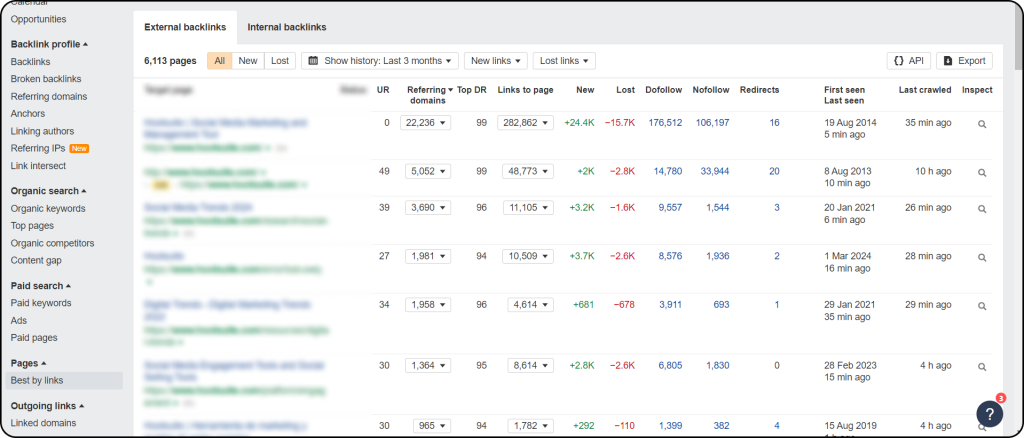
Knowing what types of competitors’ content get the most backlinks allows you to refine your content and link-building strategies.
Ok, to have a clear picture of how you can use Ahrefs for competitive backlink analysis, we should talk about both the advantages and disadvantages of this tool:
Pros
✅ Huge and accurate backlink database
✅ In-depth backlink analysis
✅ Unique features
Cons
❌ Not affordable for everyone
❌ Can be a little harder to use for newbies.
❌ Not having a free plan or trial
Once you’ve researched Ahrefs’ pros and cons and decided it’s the tool for you, the next step is to explore its pricing. Let’s get started.
Ahrefs pricing
Lite– starts at$129 /mo
Standard-starts at 249 /mo
Advanced-starts at $449 /m
Enterprise-starts at $14,990 /yr
Semrush
We don’t want to participate in the Semrush vs. Ahrefs debate now. However, we have to start by saying that this tool is also invaluable for competitive analysis. It helps you analyze your competitor’s organic traffic, its sources and top-performing keywords. You can also monitor competitor backlink profiles and check their backlinks’ authority and relevance.
Now, let’s discuss how to find and analyze competitor backlinks and find potential link-building opportunities using Semrush.
Step 1: Log in to your SEMrush account.
Step 2: Enter your competitor’s website URL into the search bar.
Step 3: Navigate to the Backlink Analytics section and check the Backlinks tab for a list of backlinks.
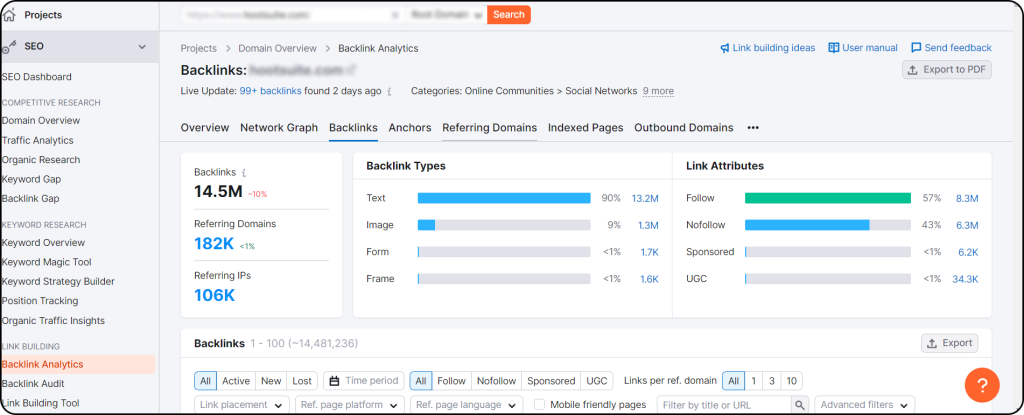
Step 4: Go to the Referring Domains tab to find websites linking to your competitor. You can filter these by data authority score (we choose the form 51-60 option).
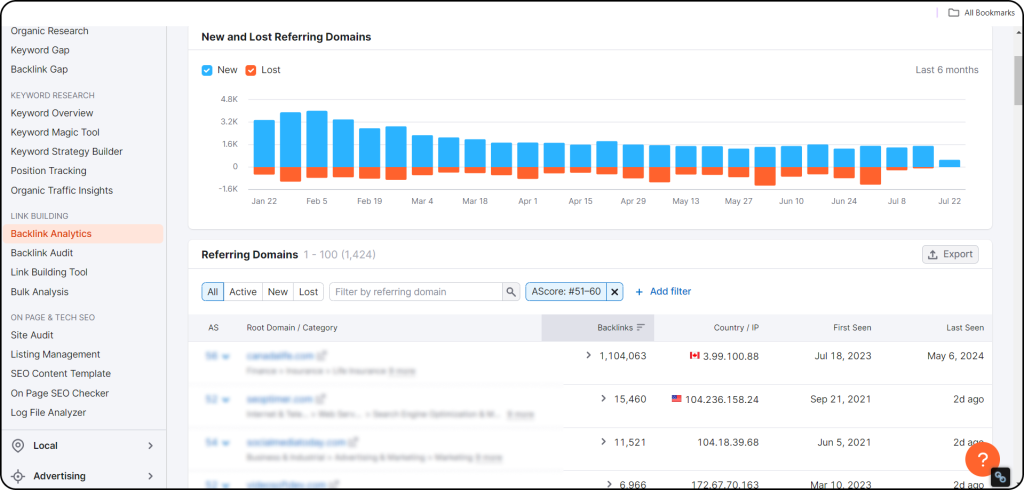
Now you have a list of reputable websites, your competitors have backlinks, and you can have them, too.
We should be fair and speak about the pros and cons of Semrush, as we did for Ahrefs.
Pros
✅ Large and frequently updated backlink database
✅ User-friendly interface
✅ Free plan
Cons
❌ More expensive than Ahrefs
❌ Gives data for only Google
After having all the necessary information, you may prefer Semrush as your SEO analytics tool, you should know about its pricing as well:
Semrush pricing
Pro– $139.95 monthly
Guru– $249.95 monthly
Business– $499.95 monthly
Moz
Moz is another well-known SEO too that can be extremely helpful for competitive backlink analysis. Using its Link Intersect feature, you can find all domains that link to your competitors but not to you.
Here are the exact steps that how you can do that:
Step 1: Enter your domain in the first field of Link Intersect.
Step 2: Add your competitors’ URLs below. You can enter from two to five competitors’ domains.
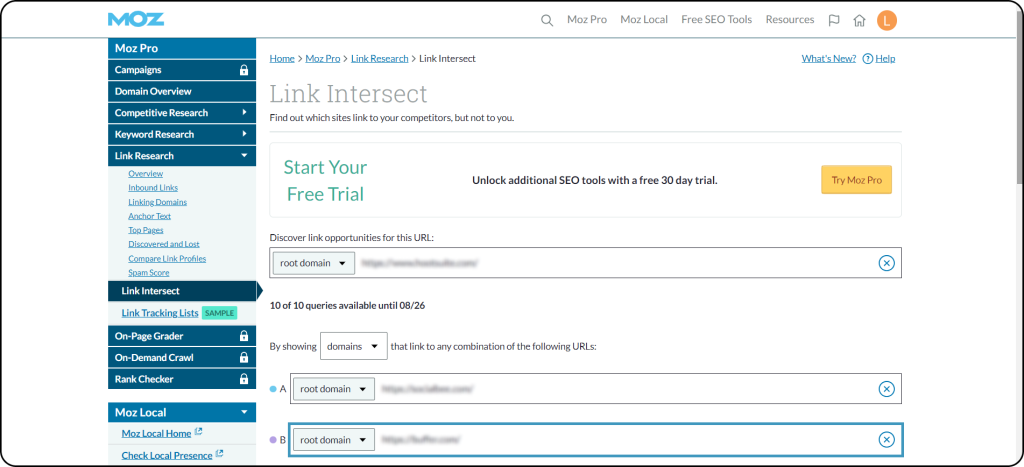
Step 3: Click on the Find opportunities and get a list of domains that link to your competitors, but not to you.
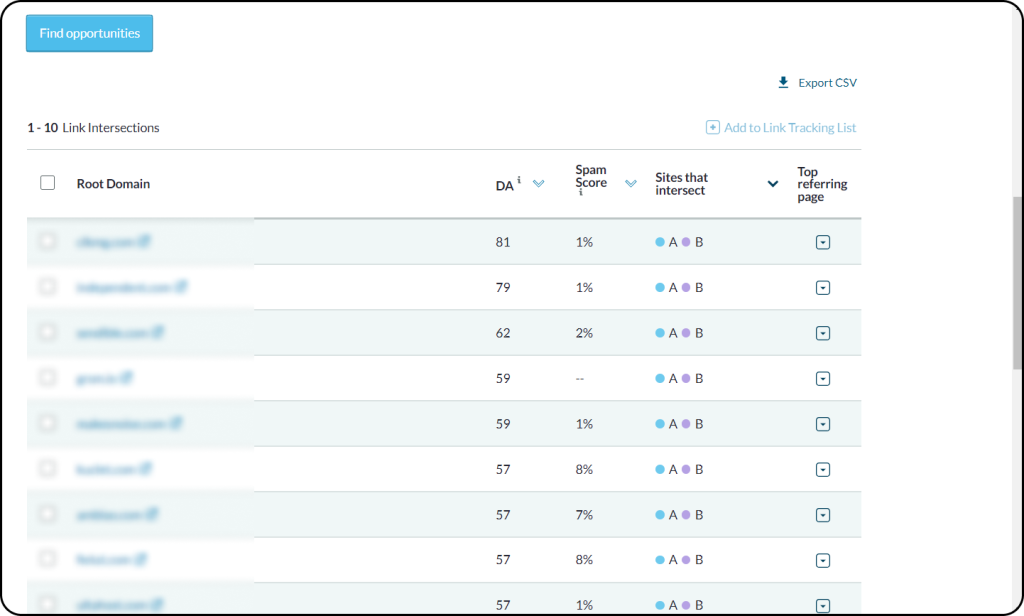
Here is another valuable data you can use to strengthen your backlink profile.
Now, it’s time to discover the advantages and drawbacks Moz has.
Pros
✅Trustworthy and reliable
✅Great balance of features
✅Free Backlink Checking
Cons
❌Limited data compared to Ahrefs or Semrush
❌Data updates are slower than Ahrefs or Semrush
❌Limited free version features
Let’s not break with tradition and present Moz pricing as well.
Moz pricing
Starter-$49USD / mo
Standard-$99USD / mo
Medium-$179USD / mo
Large– $299USD / mo
All these tree tools are great. When choosing which one to use for competitor backlink analysis, start setting your link-building goals and budget. Choose the solution that matches these factors and use its power to grow your backlink profile.
To sum up
It’s already clear that you can’t enhance your link-building strategies without a proper competitor backlink analysis. Combining valuable insights that this analysis gives with other effective link-building strategies, you can boost your website’s rankings.
To maintain a strong backlink profile, you need to regularly analyze your competitors’ backlinks as well. We spoke about the benefits of this process and gave tips on how to effectively analyze competitor backlinks.
Moreover, we suggested tips on how to use collected data to enhance your link-building efforts. Good luck with boosting your website’s performance.
Stay tuned for more informative articles!
FAQ about competitor backlinks analysis
How to beat competitors by analyzing their backlinks?
By discovering the strengths and weaknesses of competitors’ backlink profiles, you can use that information to build your own strategies that will help you to outrank your competitors.
What is a backlink pyramid?
The backlink pyramid is a strategy that involves creating a tiered structure of backlinks to a website and aims to enhance any website’s backlink profile. The pyramid consists of multiple tiers or levels of backlinks, where each level supports and strengthens the level above it.
What are the quality factors of backlinks?
The quality of backlinks is determined by different factors, such as authority, trustworthiness, and relevance.
What is the most powerful type of backlinks?
Do-follow backlinks may be considered as the most valuable type of backlinks since they contribute to the domain authority of a website and boost its search engine rankings. When authoritative websites link to the other website through do-follow links, it’s a sign to search engines that the content is valuable and trustworthy. Moreover, those backlinks will effectively increase the website’s discoverability and visibility.



